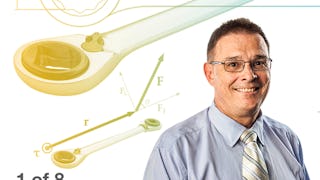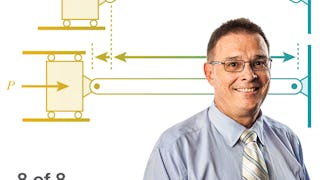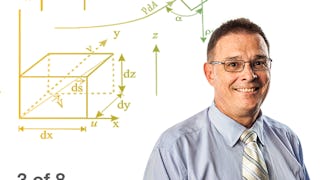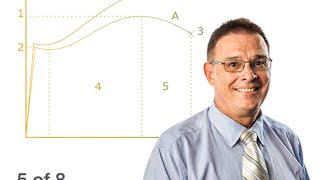This course applies principles learned in my course “Introduction to Engineering Mechanics” to analyze real world engineering structures. You will need to have mastered the engineering fundamentals from that class in order to be successful in this course offering. This course addresses the modeling and analysis of static equilibrium problems with an emphasis on real world engineering systems and problem solving.


(1,192 reviews)
Skills you'll gain
Details to know

Add to your LinkedIn profile
5 assignments
See how employees at top companies are mastering in-demand skills

There are 5 modules in this course
In this section, students will learn the applications of the equations of static equilibrium to interacting bodies or parts of a structure. Students will learn about systems containing multi-force members, frames, and machines.
What's included
5 videos13 readings1 assignment
In the section students will learn about Truss structures, specifically method of joints, method of sections, and zero force members.
What's included
5 videos11 readings1 assignment
In this section students will learn about space trusses and will be introduced to shear force and bending moment diagrams.
What's included
7 videos11 readings1 assignment
In this section, students will learn about cable support systems, specifically concentrated loads and suspension loads.
What's included
5 videos8 readings1 assignment
In this section students will learn about coulomb friction and belt friction.
What's included
8 videos12 readings1 assignment
Instructor

Offered by
Explore more from Mechanical Engineering
 Status: Preview
Status: PreviewGeorgia Institute of Technology
 Status: Preview
Status: PreviewGeorgia Institute of Technology
 Status: Preview
Status: PreviewGeorgia Institute of Technology
 Status: Preview
Status: PreviewGeorgia Institute of Technology
Why people choose Coursera for their career




Learner reviews
1,192 reviews
- 5 stars
86.32%
- 4 stars
11.99%
- 3 stars
1%
- 2 stars
0.16%
- 1 star
0.50%
Showing 3 of 1192
Reviewed on Dec 3, 2020
the way the instructor lectures, it is very easy understand and it gives a real life situations that the students need to visualize for us to really learn it better.
Reviewed on Nov 16, 2024
The course and all the materials are both comprehensive and informative. I greatly enjoyed the course, in terms of both the instruction and resources that were provided.”
Reviewed on Dec 13, 2024
very informative and interesting. the teacher is very interested in his subject. Good overall experience. highly recommend doing this course .

Open new doors with Coursera Plus
Unlimited access to 10,000+ world-class courses, hands-on projects, and job-ready certificate programs - all included in your subscription
Advance your career with an online degree
Earn a degree from world-class universities - 100% online
Join over 3,400 global companies that choose Coursera for Business
Upskill your employees to excel in the digital economy
Frequently asked questions
To access the course materials, assignments and to earn a Certificate, you will need to purchase the Certificate experience when you enroll in a course. You can try a Free Trial instead, or apply for Financial Aid. The course may offer 'Full Course, No Certificate' instead. This option lets you see all course materials, submit required assessments, and get a final grade. This also means that you will not be able to purchase a Certificate experience.
When you purchase a Certificate you get access to all course materials, including graded assignments. Upon completing the course, your electronic Certificate will be added to your Accomplishments page - from there, you can print your Certificate or add it to your LinkedIn profile.
Yes. In select learning programs, you can apply for financial aid or a scholarship if you can’t afford the enrollment fee. If fin aid or scholarship is available for your learning program selection, you’ll find a link to apply on the description page.
More questions
Financial aid available,

